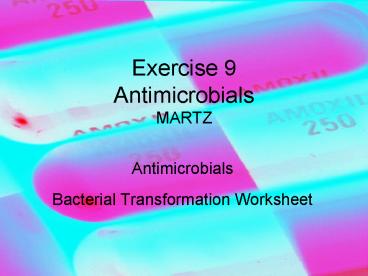Exercise 9 Antimicrobials MARTZ - PowerPoint PPT Presentation
1 / 27
Title:
Exercise 9 Antimicrobials MARTZ
Description:
Insisted on washing hands between patients in hospitals, particularly maternity ward ... Mid to late 1800's Lister. Sterilized surgical instruments ... – PowerPoint PPT presentation
Number of Views:39
Avg rating:3.0/5.0
Title: Exercise 9 Antimicrobials MARTZ
1
Exercise 9AntimicrobialsMARTZ
- Antimicrobials
- Bacterial Transformation Worksheet
2
Antimicrobials
- Historical perspective
- Mid 1800s Semmelweis
- Insisted on washing hands between patients in
hospitals, particularly maternity ward - Mortality rate (from peurperal fever) reduced
from 13 to less than 1 - Mid to late 1800s Lister
- Sterilized surgical instruments
- Mortality rate (from surgery) reduced from 50 to
15
3
Antibiotics
- First attempts to use antibiotics on people
- Bad side-effects
- Determined to be too dangerous
- Ehrlich's magic bullet (1909)
- Found dyes which could penetrate microorganisms,
but not animal tissue - Reasoned that chemicals could attack pathogens,
but not hosts magic bullets - Discovered a chemical to treat syphilis
- Salvarsan or preparation 606
4
Antibiotics
- Ehrlich stressed selective toxicity as key factor
in success - Specific to the pathogen
- Do not harm the host
- The search for antibiotics was refined
- Penicillin was introduced in 1945
5
History of Antimicrobials
- Germ Theory Microorganisms can invade other
organisms and cause disease - Growing acceptance of the germ theory at the end
of the 19th century led to the search for
antimicrobial compounds.
www.molbio.princeton.edu
Alexander Fleming, who discovered that the mold
Penicillium produced a compound that lysed
Staphylococcus cells he had streaked on a plate.
6
History of Antimicrobials
www.molbio.princeton.edu
7
Control of Microbial Growth
- Microbial growth is never truly controlled
- Try to discourage harmful microorganisms
- Microorganisms that cause disease, spoil food,
corrode machinery - Try to encourage beneficial microorganisms
- Microorganisms that ferment beer or cheese,
produce antibiotics or insulin
8
Antimicrobials
- Bactericidal
- Kills the bacteria
- Bacteristatic
- Inhibits growth of the bacteria
9
Antimicrobials
- Sterilizing Agents
- Kill everything
- Autoclave (heat and pressure), radiation
- Disinfectants
- Kill most things, too strong for living tissues
- Lysol, ammonia
- Antiseptics
- Prevent growth, can be used topically
- Alcohol, iodine, hydrogen peroxide
- Chemotherapeutics
- Kill microbes or prevent growth, can be ingested
- Penicillin, sulfa drugs
10
Chemotherapeutics
- Can be ingested to control microbial growth
- Selectively kill or inhibit growth of harmful
microorganisms - Antibiotics
- Chemicals produced by one organism that kill or
inhibit growth of other organisms
11
Antibiotics Selective toxicity and target
organisms
- Bacteria
- Specific to the pathogen
- Do not harm beneficial host microflora
- Eukaryotes (such as fungi and protozoa)
- Viruses
12
Known sources of antibiotics
- Mold-type fungi
- Penicillin from Penicillium species
- Cephalasporin from Cephalosporium species
- Certain strains of Bacillus
- Bacitracin, Neosporin, Polysporin
- Many strains of Actinomycetes
- Streptomycin from Streptomycetes species
- Majority of antibiotics come from these organisms
13
Antibiotics Antimicrobial Susceptibility Testing
- Potential pathogen isolated from a patient
- Determine susceptibility to antimicrobial drugs
- Determine treatment of patient
- Antimicrobial susceptibility testing (AST) is
routine procedure in clinical laboratories - Susceptibility to antimicrobials may change
- Microorganism acquire drug resistance
14
Antibiotic Combinations
- Intended to enhance inhibition
- Antibiotic synergism two (or more) antibiotics
work together - Enhanced inhibition
- Antibiotic antagonism two (or more) antibiotics
work against one another - Decreased inhibition
15
Antibiotics Antimicrobial Susceptibility Testing
- AST methods
- Minimum inhibitory concentration (MIC)
- Uses serial dilutions
- Kirby-Bauer
- Uses agar plates, lawn cells, and antibiotic disks
16
Minimum inhibitory concentration (MIC)
- Uses serial dilutions
- Determines minimum concentration that inhibits
growth - This is that point at which bacterial growth is
bacteriostatic
17
Kirby-Bauer
18
Zones of Inhibition
- Zones can be resistant, intermediate, or sensitive
19
Antimicrobials ExercisePurpose
- Use Kirby-Bauer method
- Compare sensitivity of Gram-negative and
Gram-positive organisms to antibiotics - Gram-negative organisms
- Escherichia coli and Pseudomonas aeruginosa
- Gram-positive organism
- Staphylococcus epidermidis
20
Antimicrobials ExercisePurpose
- Determine antibacterial spectrum
- Broad-spectrum inhibits a wide variety of
Gram-positive and Gram-negative bacteria - Narrow-spectrum inhibits a limited variety of
bacteria
21
Antimicrobials ExerciseProcedure
- Prepare plates with bacterial lawn
- Apply a variety of antibiotic disks
- Each disk is impregnated with an antibiotic
- Incubate plates
- Measure zones of inhibition
22
Antimicrobials Exercise Antibiotic Disks
GM 10
P 10
K 30
TMP 5
TE 30
SXT 25
PB 300
C 30
S 10
E 15
Cl 10
G 300
Figure 9.2. Antibiotic disk placement. (Shand
2003)
23
Antimicrobials ExerciseZone of Inhibition
Figure 9.1. The size of a zone of inhibition
around a high potency disk reflects the
resistance or sensitivity of the bacterium.
Bacteria may also exhibit an intermediate
reaction. (Shand 2003)
24
Antimicrobials ExerciseZones of Inhibition
25
Antimicrobials ExerciseZone of Inhibition
- Bactericidal
- Kills the bacteria
- Bacteristatic
- Inhibits growth of the bacteria
26
Bacterial Transformation
- Examine plates for growth
- Where do you expect to see growth?
- Count all colonies and fill out worksheet on p.
8-3
27
Transformation Plates
SD6 mutant lawn
1/100
U
1/10
Transformation Plate































